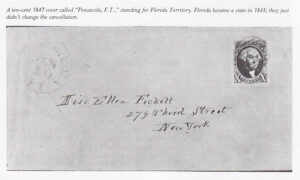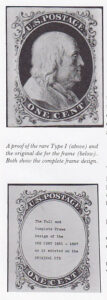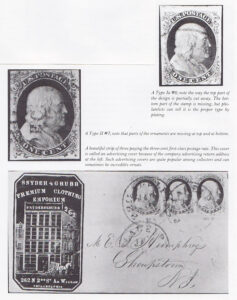In 1851, another general postage rate reduction was deemed in order. The price of sending a drop letter (a letter dropped off at a post office for someone else to pick up) was reduced from 2 cents to 1 cent. Furthermore, the first-class rate was lowered from 5 cents to 3 cents, and a five-cent stamp was issued for use on letters that traveled b ship. A ten-cent stamp was issued for mail sent from the East to the West coast. A twelve-cent stamp for foreign letters rounded out the set. All values are imperforate.

 The One Cent 1851 (#5, 6, 7, 8, 8A, 9)
The One Cent 1851 (#5, 6, 7, 8, 8A, 9)
This is one of American philately’s most difficult and most interesting stamps. All the one-cent 1851 stamps look alike to the casual collector. However, there are several types that philatelists recognize as different stamps. The differences were caused when the stamp die was transferred to the transfer roll. Individual cuttings by the engraver of each position on the plate would be an endless task. And a die cannot be directly transferred to the plate because both the die and the plate need to be in reverse. A transfer roll is the intermediate step. So this form of exact reproduction was developed, and it has remained the most effective security printing method to this day. On the one cent 1851, the types of the stamp are due to varieties caused during the transfer of the die to the plate, and by plate wear.
Not all collectors care to differentiate among the various types, as these minutely different stamps are called. Still with the rarest type, Type I, selling at about 10,000, and the most common type selling at $40, it makes sense to learn. The types of the one cent 1851 are the hardest part of United States philately; once you master them, everything else is relatively easy. Remember, of course, that most of philately deals with minutiae, and each collector can decide for himself how specialized he wants to become. This degree of specialization is one of the watersheds that separates advanced from casual collectors.
The Types of the One Cent 1851
–Type I (#5) The complete design as it was engraved on the die. This is found in only one position on the plate. The ornaments are complete at the bottom, top, and sides. Though 30,000 were estimated printed, only a tiny fraction are known to philatelists—there are probably quite a few left to be discovered. This stamp is worth anywhere from $1,000 to $10,000, depending on condition.
–Type Ia (#6) Similar to Type I except that the top frameline is partially cut away.
— Type II (#7) This is one of the more common types. It has parts of the design missing at its top and bottom, but the lines below “ONE CENT” and above “U.S. POSTAGE” are always intact.
— Type III (#8) There are major pats of the design missing at the top and bottom always including the lines below “ONE CENT” and above “U.S. POSTAGE.”
— Type IIIa (#8a) The line below “ONE CENT” or the line above “U.S. POSTAGE” is broken, but not both.
— Type IV (#9) As plate one started to wear, the lines at the top and bottom began to disappear, so they were recut: this means that an engraver went to the plate and individually strengthened the lines. The effect shows up as dark lines above “U.S. POSTAGE” and/or below “ONE CENT” on the Type IV.
The one-cent 1851 stamp is one of America’s most popular specialty stamps. There are many different types, a fascinating array of cancels, and this stamp is easier to plate (see page 27) than any other American stamp. It is difficult to find good four-margin examples of this stamp and they command premiums.

 The One Cent 1851 (#5, 6, 7, 8, 8A, 9)
The One Cent 1851 (#5, 6, 7, 8, 8A, 9)